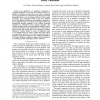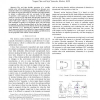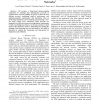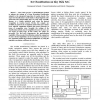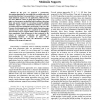FUZZIEEE
2007
IEEE
15 years 7 months ago
2007
IEEE
— The application of Qualitative Reasoning to Learning Algorithms can provide these models with the capability of automate common-sense and expert reasoning. Learning algorithms ...
101
Voted
FUZZIEEE
2007
IEEE
15 years 7 months ago
2007
IEEE
— Geometric Type-2 Fuzzy sets allow us to model type-2 fuzzy sets using geometry providing significant improvement in speed of computation. This paper explores in detail how wel...
102
click to vote
FUZZIEEE
2007
IEEE
15 years 7 months ago
2007
IEEE
Abstract—In contrast to standard fuzzy clustering, which optimizes a set of prototypes, one for each cluster, this paper studies fuzzy clustering without prototypes. Starting fro...
94
Voted
FUZZIEEE
2007
IEEE
15 years 7 months ago
2007
IEEE
—In this paper, we propose a new nonlinear classier based on a generalized Choquet integral with signed fuzzy measures to enhance the classification power by capturing all possib...
110
Voted
FUZZIEEE
2007
IEEE
15 years 7 months ago
2007
IEEE
— The real time flexible operation of a car-like mobile robot with nonholonomic constraints in dynamic environment is still a very challenging problem. The difficulty lies in t...
84
Voted
FUZZIEEE
2007
IEEE
15 years 7 months ago
2007
IEEE
— We propose a fuzzy-based decision-making mechanism for selecting data dissemination protocols in wireless sensor networks (WSNs). Its goal is to select the most efficient proto...
FUZZIEEE
2007
IEEE
15 years 7 months ago
2007
IEEE
—Sailing experts can explain basic sailing skills by rules about how to steer sails and rudder according to direction of target and wind. This paper describes how to transform th...
103
Voted
FUZZIEEE
2007
IEEE
15 years 7 months ago
2007
IEEE
— This article presents a self-fuzzification method to enhance the settings of a Fuzzy Reasoning Classification adapted to the automated inspection of wooden boards. The supervis...
80
Voted
FUZZIEEE
2007
IEEE
15 years 7 months ago
2007
IEEE
— An iterative feature selection method based on feature typicality and interactivity analysis is presented in this paper. The aim is to enhance model interpretability by selecti...
104
click to vote
FUZZIEEE
2007
IEEE
15 years 7 months ago
2007
IEEE
—In the past, we proposed a genetic-fuzzy data-mining algorithm for extracting both association rules and membership functions from quantitative transactions under a single minim...
